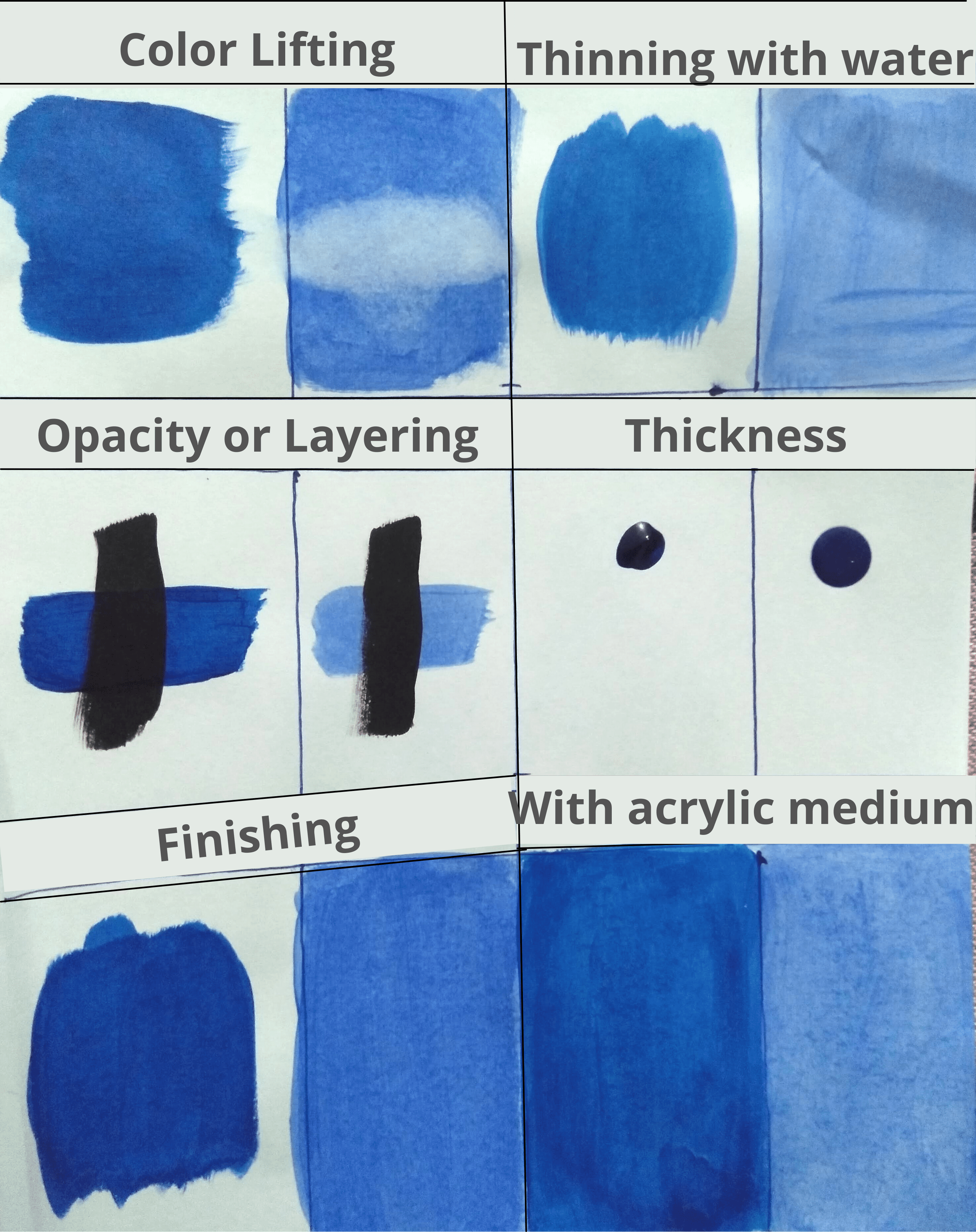When you are at the art store you may have come across tempera paint. Also, you might have noticed how cheap they are. Essentially you can buy 16 ounces of tempera paint for only 5 USD. You might also see acrylic paint at the art store and these two paints are different in many ways.
Tempera paint is an inexpensive and safe option for kids for school art projects. Thus they are less permanent and durable when compared to acrylics. Acrylic paint is expensive and used by artists on canvas while tempera paint is best for paper. Tempera paint is translucent compared to most acrylic paint.
Some artists use tempera paint as an alternative for acrylic paint in acrylic pouring. Whether you want to do pour art or paint with a brush, you need to know the different properties of tempera paint. Especially if thinking about replacing expensive acrylics with cheap tempera paint.
I have written a whole article comparing all the water-based paints to acrylic paint. You can find a detailed comparison of each water-based paint and acrylic paint including a nice summary with a handy chart.
What is tempera paint?
Tempera paint is meant for students for their art projects and it is very translucent and less permanent. In, general, they are non-toxic, free from allergens, and safe for children above 3 years old. The main ingredients of tempera are water, pigments, calcium carbonate, starch, and cellulose.
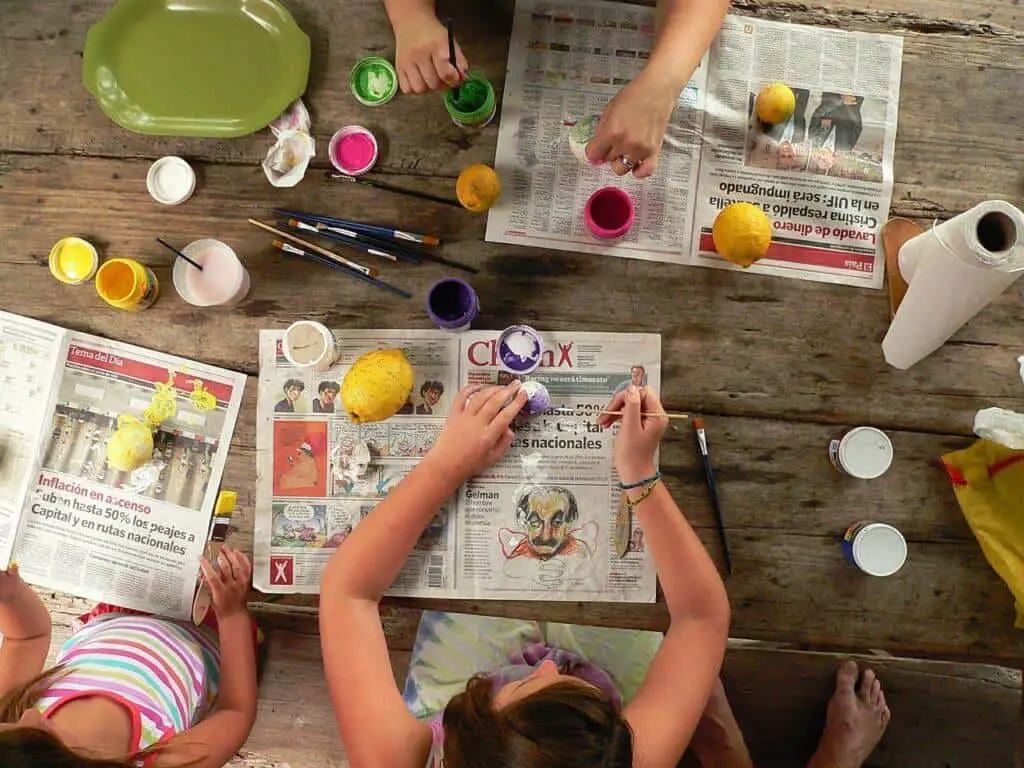
What is acrylic paint?
In general, acrylic paint is made for artists, students, and crafters to use on canvas and for craft projects. They dry quickly into a plastic layer that is waterproof and permanent which can be used on almost any surface. The ingredients are pigment, acrylic polymer binder, filler, and additives.
Key differences between tempera and acrylic paint
I have summarized all the key differences between tempera paints and acrylic paint in the following table.
| Aspect | Tempera paint | Acrylic paint |
| Binders | Water-soluble binders such as cellulose or starch | Water-resistant acrylic polymer binder which is plastic |
| Pigments | Nontoxic, inexpensive, and present in low concentration | Can be toxic if ingested (eg: cadmium), high-quality rare pigments, high concentration depending on the quality |
| Usage | Nontoxic alternative for school art projects | Used by artists for displaying purposes |
| Durability/ permanency | Not permanent, easily washable even after drying | Colors are permanent after drying |
| Price | Inexpensive (0.3 USD / Fl oz) | Expensive (student acrylics: 1 USD/ fl oz, artist-quality acrylic: 5 USD/ fl oz) |
| Color lifting | colors lift relatively easily | Colors do not lift, colours are permanent after drying |
| Colors | Colors can be mixed well, not vivid and vibrant | Excellent color mixing ability, a wide range of vivid and vibrant colors can be obtained |
| Layering | Difficult to paint in layers as dried colors can be reactivated by adding water | Can easily paint in layers as colors are permanent after drying |
| Consistency | Comes as liquids and cakes | Usually comes in a heavy body, soft body, and liquid |
| Opacity | Very translucent (some can be opaque) | Opaque to the transparent color range, available in different opacities |
| Surface | Best on paper or cardboard, vibrant colors on canvas | Most surfaces like canvas, wood, plastic metal |
| Finishing | Matte, slightly chalky finish | Soft glossy finish, It can be changed using mediums |
| Lightfastness | Not lightfast | Lightfast pigments |
| Thining | Can use straight out from the bottle, no need to thin | Can be thinned with water or acrylic medium |
| Mixing with acrylic medium | No different, washy look | vibrant paint did not lose physical properties |
I experimented to compare the properties of acrylic paint and tempera paints. I used ultramarine blue in tempera paint and acrylic paint. But none of these paints indicates the kind of pigments they have. Since the two colors are the same, I just went with them. following is my results chart. I have used 80 gsm normal copy paper to paint on.
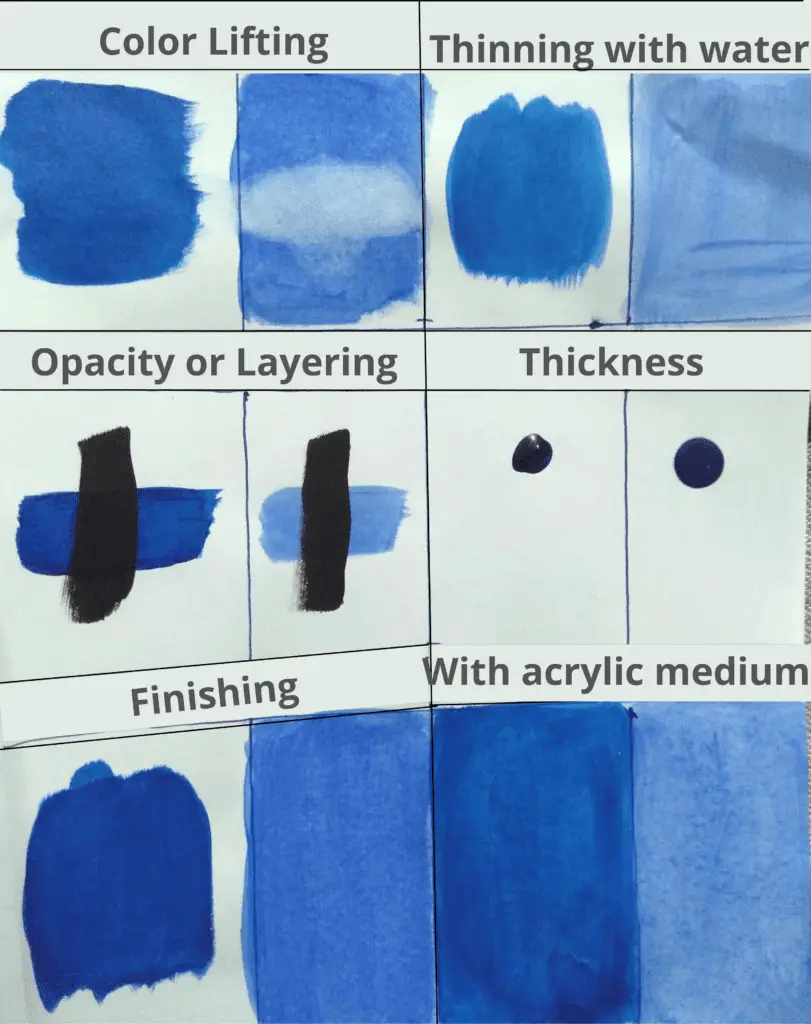
Below I have elaborated on each difference between tempera paint and acrylic paint.
Binders
I asked Crayola, a leading brand in tempera paint production, what are the general ingredients used to make tempera paint, in their tempera products line. Following is their reply.
Although the exact ingredients in our products are proprietary, we can provide a list of the most common ingredient requests NOT FOUND in products currently manufactured by Crayola; Casein, Eggs & Egg Shell, Fish/Shellfish, Latex, Milk, Nut & Nut Oil, Peanuts, Red Dye #40, Sesame & Sesame Oil, Tree Nuts and Whey.
Consumer Care Professional at Crayola
So instead of getting an ingredient list of their tempera paint. I have got a list of ingredients that are not in their products. Mostly allergens. If you or your kids have allergies, you can check this list or the product label for allergen information.
Both acrylic and tempera paints are a combination of pigments and binders. Tempera painting has water-soluble binders like cellulose and starch. They are inexpensive and non-toxic, even for kids. On the other hand, watercolor, gouache, and poster colors use gum arabic as their binders which is slightly expensive.
Acrylic colors have liquid acrylic polymer binder which is essentially plastic. Therefore acrylic paint is water-resistant after drying while tempera paint can be redissolved in water. An acrylic polymer binder can bind the pigments together.
When exposed to air, water in acrylic paint evaporates. The binder will aggregate in hexagonal forms, trapping the pigments. It will then dry into a water-resistant thin film. This does not happen with tempera paint. It just dries into a slightly chalky finishing which can be reactivated with water.
Pigments
Tempera colors have inexpensive nontoxic pigments. However, in some tempera paints, the pigment concentration is very low making tempera paint very translucent.
Some acrylic colors can have toxic pigments such as cadmium. Therefore be careful when giving acrylics to your kids. But generally, you are safe as long as you don’t eat your paint. Try not to hold your brushes too close to the mouth.
Acrylics are a good option if you are thinking about preserving the paintings of your kids. You can give them acrylics under your supervision.
Usage
Tempera paint is used for kids’ classroom art projects, posters, craft projects, window painting, and theatre props, for kids to learn color mixing and different techniques using paint. Since they are inexpensive and nontoxic, kids can use paint in large quantities and allow them to be messy.
Acrylic is used by students to professional artists. They can be painted on canvases, acrylic pads, wood, glass, metal plastic, and almost any dry surface. Acrylic paint art is usually for display purposes and durability is very high.
Artists do not use tempera paint made for kids. They use egg tempera paint which is entirely different from regular tempera paint. Egg tempera is made by mixing dry pigments with egg yolk. These paints are very translucent and have fewer pigments than acrylics. Hence best for glazes and translucent paint layers.
Durability or permanency
One of the most important aspects when comparing tempera and acrylic paint is durability or permanency.
Acrylic colors last longer without fading when exposed to sunlight. meaning they are lightfast. Especially when you add a protective topcoat to the finished painting such as varnish. Before painting also, make sure you prime the surface with gesso to ensure paint adhesion.
Lightfastness is indicated on the label of the acrylic painting tube. Mostly, artist-grade acrylics have the most lightfast pigments when compared to student-grade or craft-quality acrylics. So if you want to preserve your artwork for a long time, go with paint with lightfastness.
In general tempera paint is not lightfast. The paints can be faded away when exposed to sunlight. But some tempera paint brands claim their tempera products are lightfast, meaning the paintings can be preserved for a long time.
If you want to preserve your kid’s paintings for a long time and want nontoxic paint at the same time, then go for tempera paint with lightfastness on the label. If you are very serious about preserving the painting for a long time for selling your artwork, then buy artist grade or student grade acrylic paint, when toxicity is not much of a concern.
However, adding a top coating on top of tempera artwork may preserve it for a long time. This coating can be an acrylic varnish or any water-soluble clear coating.
Price
Craft and student-grade acrylics cost an average of 1 USD/ Fl oz while artist-grade acrylics cost around 5 USD/ Fl oz . Tempera paint cost an average of 0.3 USD/ Fl oz .
Acrylic paints are more expensive. The prices depend on the pigments used. Artist-quality acrylics have high-quality pigments in high concentrations. Therefore it has higher prices. Price may vary according to how expensive the pigments are and how difficult it is to find the pigments and produce paint.
Acrylics also come in student quality and craft quality. They have low pigment density and more filler and are relatively cheaper than artist-quality acrylics.
Tempera paints are less expensive than acrylic paints. Tempera paints use inexpensive binders such as cellulose and starch. Also, they have very little pigment density. Therefore the pigment itself is inexpensive.
Color lifting
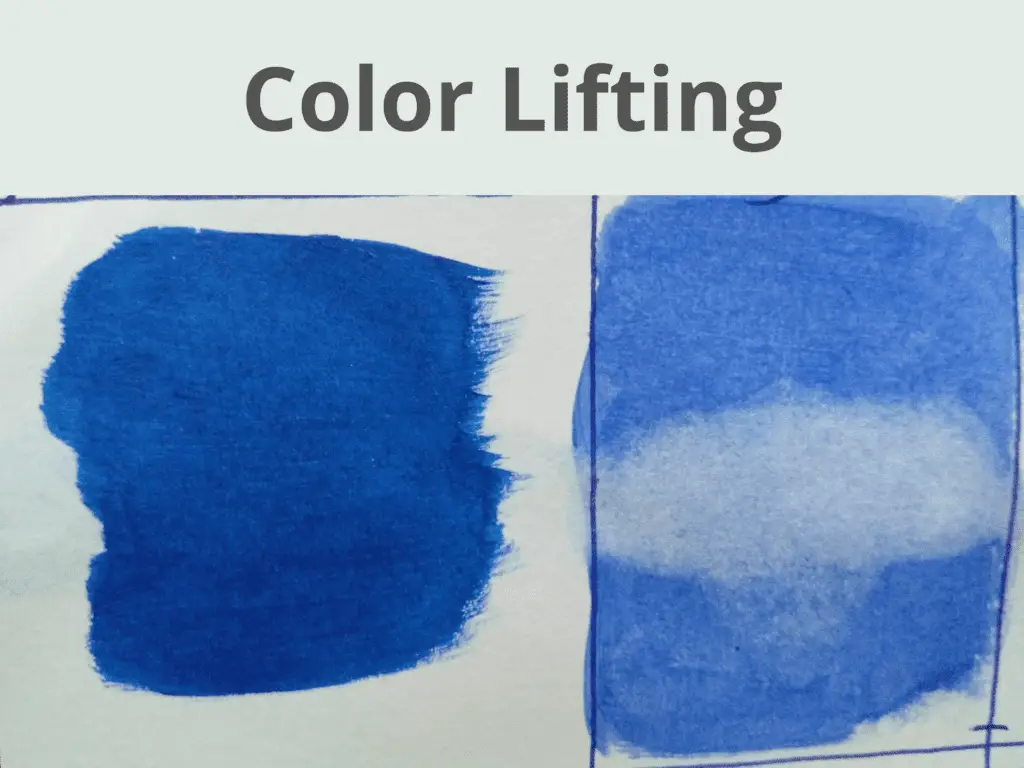
Color lifting is how easy it is to redissolve the paint with some water and remove the paint by dabbing it with tissue paper. It allows you to correct any painting mistakes.
You can see in the image that tempera paints can be easily lifted with some water, while acrylic paints do not move at all. This is because tempera paints can be easily reactivated with some water.
On the other hand, acrylic paint cannot be redissolved and lifted after drying. But if you want to correct a mistake or want to have a white area to work on, you can easily add a top paint layer. It will not disturb the paint layer underneath.
Opacity
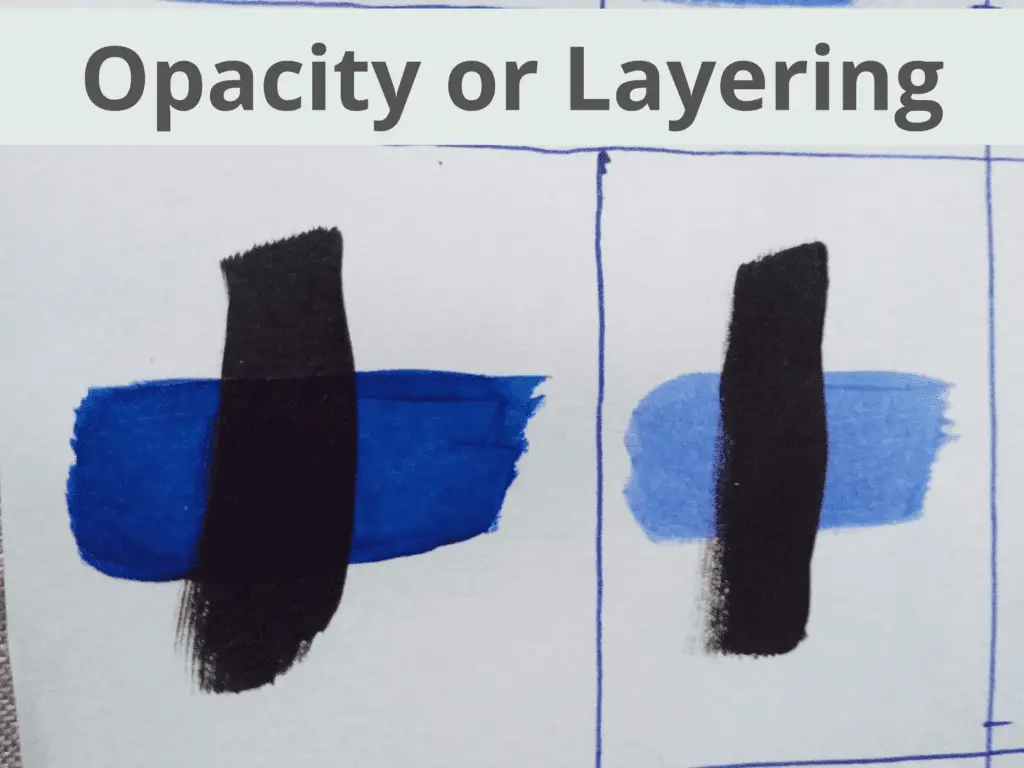
Opacity refers to how less transparent the paint looks on the painting surface. There is high opacity when it is hard to see the below paint layer through the top paint layer. The tempera paint I used is very translucent as mentioned before.
You can see in the above image, how you can see the black paint line underneath through the top paint layer. It does not cover the paint layers underneath at all. But this may not be an issue for kids. As the paint is vibrant they may like it.
However, you can buy opaque tempera paint as well. Usually, the washable tempera paints are translucent. Crayola mentions on their website that, their premier tempera paints have ultimate opacity, Artista II washable tempera paints have medium opacity and washable tempera paints are translucent.
The following Artists II washable tempera paints on Amazon are what I recommend if you want a washable tempera paint with medium opacity.
If you want good value for your bucks with the most opaque non-toxic tempera paints from Crayola, the following are the best options on Amazon. Choosing only primary colors with this paint and mixing other colors will be the best option.
As you can see, you can buy tempera paints in different opacities also, according to your needs.
Acrylic paints are available in different opacities. If buying artist-quality acrylics, you can see a swatch of paint on top of some black stripes. You can determine opacity by how much you can see the black stripes through the paint. The label will also have other indications of opacity.
Craft or student-grade acrylics usually are less opaque and more translucent. The acrylic paint I used here is a student grade one. Also, the opacity is determined by the type of pigment in acrylic paint.
Here I have written a whole article about, why acrylic paint is not covering the paint layers underneath. You can find opacities of different pigments in different acrylic paint brands.
Color mixing
The tempera paint I used is very transparent. The mixed colors also had the same transparency. However, the colors seem to be vibrant but translucent, straight from the bottle as well as after being mixed.
With acrylic paints the color mixing abilities are endless. You can make any color by mixing. However, as acrylics dry faster you will not have much blending capacity on the canvas (oil paints have super color blending ability on canvas as it does not dry fast)
When tempera paint and acrylic paint are mixed, the acrylic color will overpower tempera paint. The mixed color dries darker than tempera paint and is more transparent than acrylic paint. When both paints are mixed in a 1:1 ratio, it looks like acrylic paint itself. Medium opacity can be achieved with 25% of acrylic paint.
Following are the results I got after mixing tempera paint and acrylic paint.
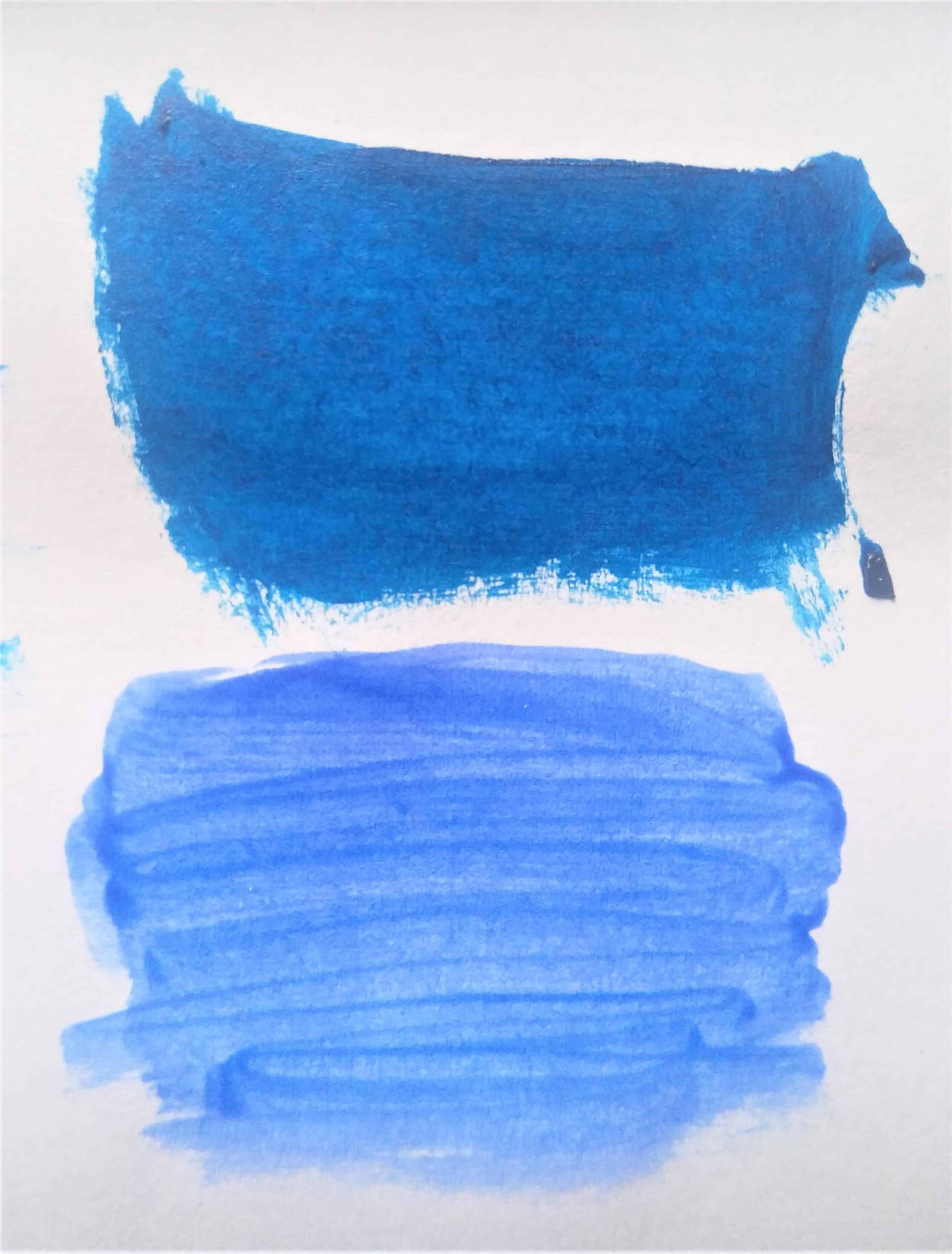
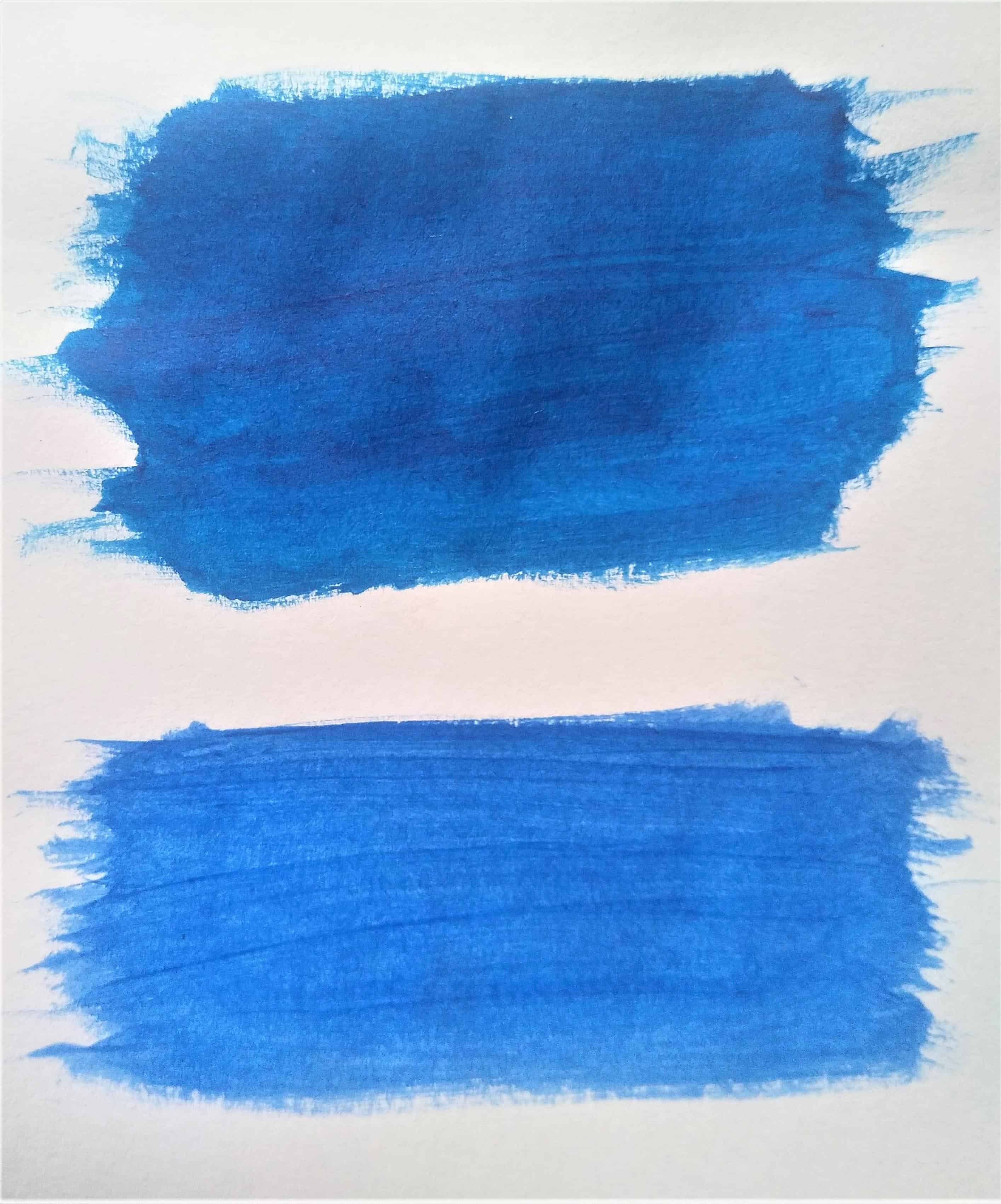
Layering

As tempera paint can be redissolved in the water it is difficult to apply layers of tempera paint on top of each other. You will reactivate the paint layers underneath and make a mixed color. However, it can be possible if you apply paint without adding too much water and apply the paint so softly to the color beneath.
The best thing about acrylic is that it can be applied in layers. The paint dries quickly and is waterproof after drying. So the top layer does not disturb the bottom layer. You can add as many acrylic paint layers as you want.
Layers of acrylic paint can be applied thinly, thickly in an impasto technique, as a glaze by using acrylic mediums and as a paste to add texture. The options are endless with acrylics while tempera paint is not made for the same purpose. It is generally made for the purposes of kid’s art projects.
Consistency
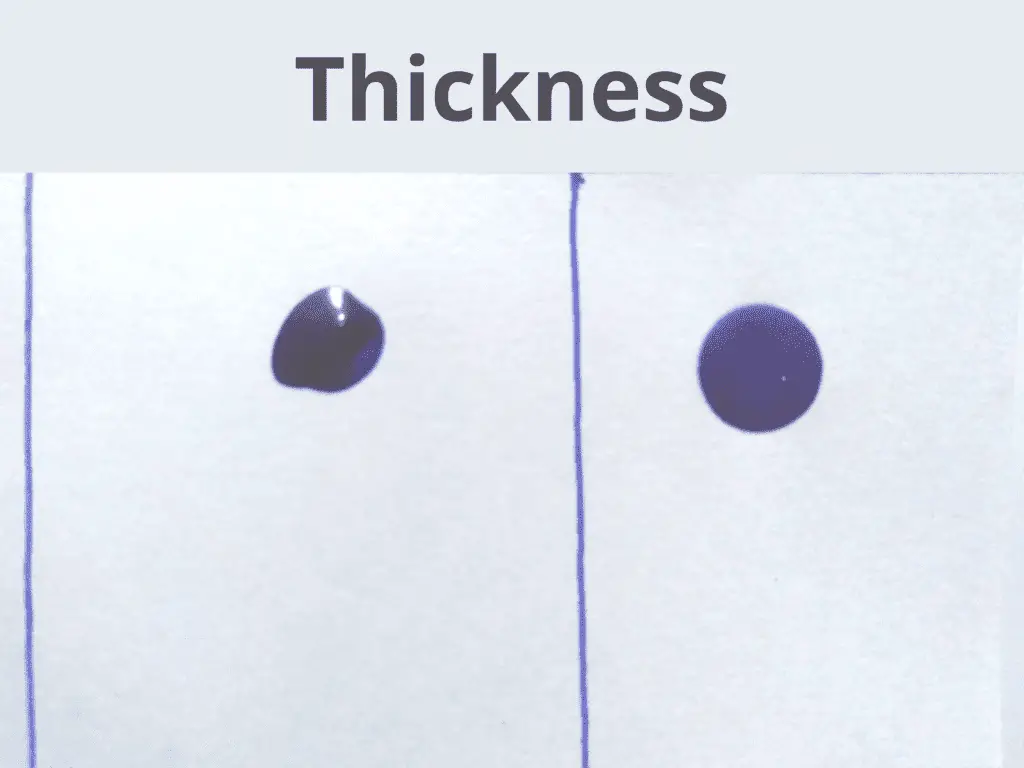
Tempera paint has a thin consistency to the paint. When taken out from the bottle, it is shaped into a half bubble and does not hold its shape. Indicating the thinness of the paint. Kids can use tempera paint straight out of the bottle, without adding water. The liquid tempera paint comes in large bottles, on average 10 oz bottles.
Tempera paint also comes as cakes. Students can take paint by mixing in some water with tempera paint cakes.
Acrylic paints are a little thicker than tempera paint. They can be bought in different consistencies. There are heavy body, soft body and, fluid acrylics paint. These different consistencies are available mostly for artist-quality paint. Craft quality acrylic paint has a medium thickness.
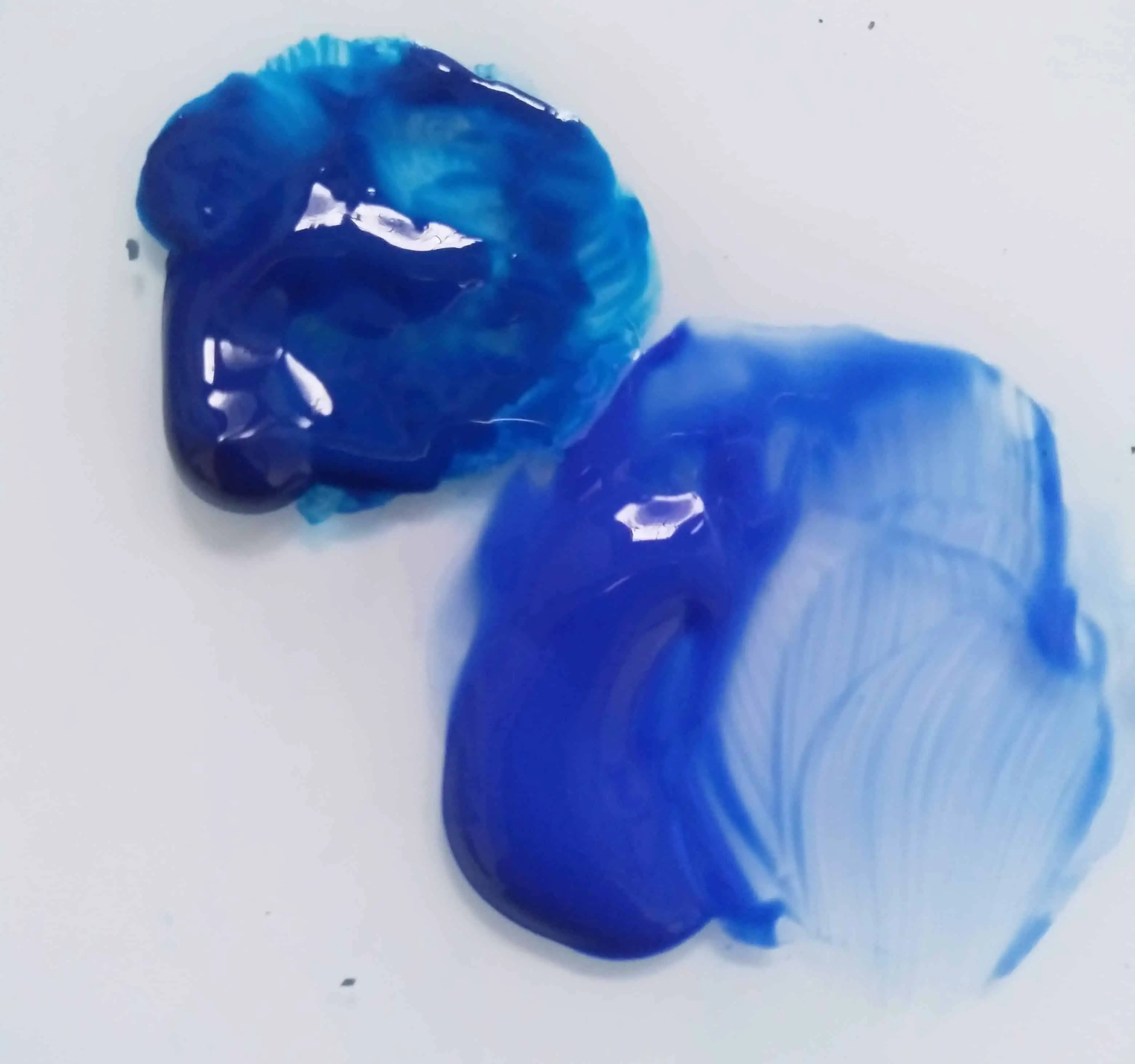
With acrylics, you can adjust the consistency. You can make the paint thick, thin glaze, textured, creamy and gel-like consistency. All by mixing the acrylic paint with different mediums.
When compared to tempera paints, acrylic paint is thicker. But tempera paint is still transparent when compared to craft quality or artists-grade acrylic paint.
Painting surfaces
You can paint with acrylics on any surface such as canvas, wood, plastic metal, etc. The paint is durable if the surface is prepared well and the finished painting was sealed. Mostly acrylics are painted on canvases by artists.
You can also buy canvas pads to practice painting. Get canvas sheets in yards to practice painting and frame them later if needed. You can save some good bucks this way.
Acrylic paint is the best option when it comes to painting on a canvas. Tempera paint is meant for paper, paper-mâché, and cardboard. But here I have tried painting tempera paint on canvas. What I observed is, tempera paint is more vibrant and has a very nice color to it on the gessoed canvas.

It seemed to be absorbed into the gesso well. It also has a slightly chalky finishing on the canvas. Although the tempera colors are vibrant, there are some caveats to it as mentioned before. Tempera paint simply cannot be applied in layers as the colors get reactivated with water. Also, the paint will not be durable and fade with time.
Tempera paints are better used on paper, paper-mâché, and cardboard. You can use any painting surface with tempera paints. Some even paint windows or glass with washable tempera paints. There is a wide variety of options for your kids to enjoy tempera paint.
Using cardboard will be the best value option as cardboard can hold more paint than a regular copy paper. But for this experiment, I have used 80 gsm normal copy paper. It is not the best option for thick paint application.
Drying time
This is one of the main characteristics when comparing tempera and acrylic paint. Acrylic paint dries so fast. It feels dry to touch within a few seconds. But if applied tickly it will take around 10 to 20 minutes to dry.
In my experiment, I painted both tempera and acrylic paint in the same thickness. Acrylic paint was dry to touch within 5 minutes. But for some reason, tempera paint took double the time to dry.
This might not be an issue with kids’ art projects or what tempera paint is made for. As tempera paint is not meant to apply in layers, this will not be an issue. However, make sure that your kids have to wait a little bit until their artwork is dry.
Finishing
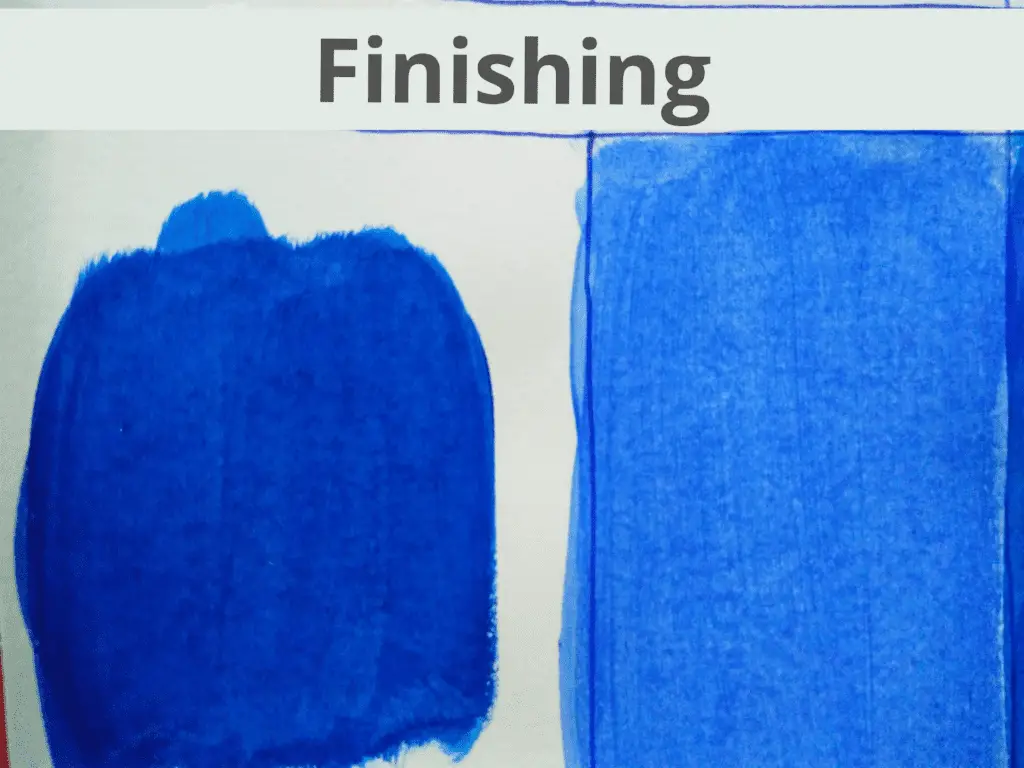
Both tempera and acrylic paints I used have a matte finishing to them. It is most visible when painted on the canvas. On canvas acrylic paints had a slight statin finishing to them while tempera paints have a slightly chalky matte finish to them.
This might be because acrylic paint forms a plastic skin on top of the paint layer with its acrylic polymer binder (plastic). But tempera paint does not have such finishing to it. It only has cellulose and starch as the binders, so giving a matte chalky finishing.
However, you can manipulate the finishing of acrylics with different mediums. As an example, you can get a matte finish by, mixing acrylic with a matte medium and gloss finishing by mixing with a gloss medium.
Thinning of acrylic and tempera paint

Acrylic paint can be thinned as it is thicker and has a high concentration of pigments. You can either use water to thin acrylic paint or you can thin it with acrylic mediums. If you want to maintain the properties of paint while thinning the paint too much, use acrylic mediums. But to slightly thin the paint, water will be enough.
Following is an article I wrote about adding water to acrylic paint and wetting the brush before painting. It will give you a good understanding of how to thin acrylic paint.
But with tempera paints, you do not need to add water. It is a ready mixed. Kids can paint straight out of the bottle. You can see in the image also, that after mixing with water, tempera paint looks more like a wash. Acrylic paint also has a watercolor look, but still maintains its opacity.
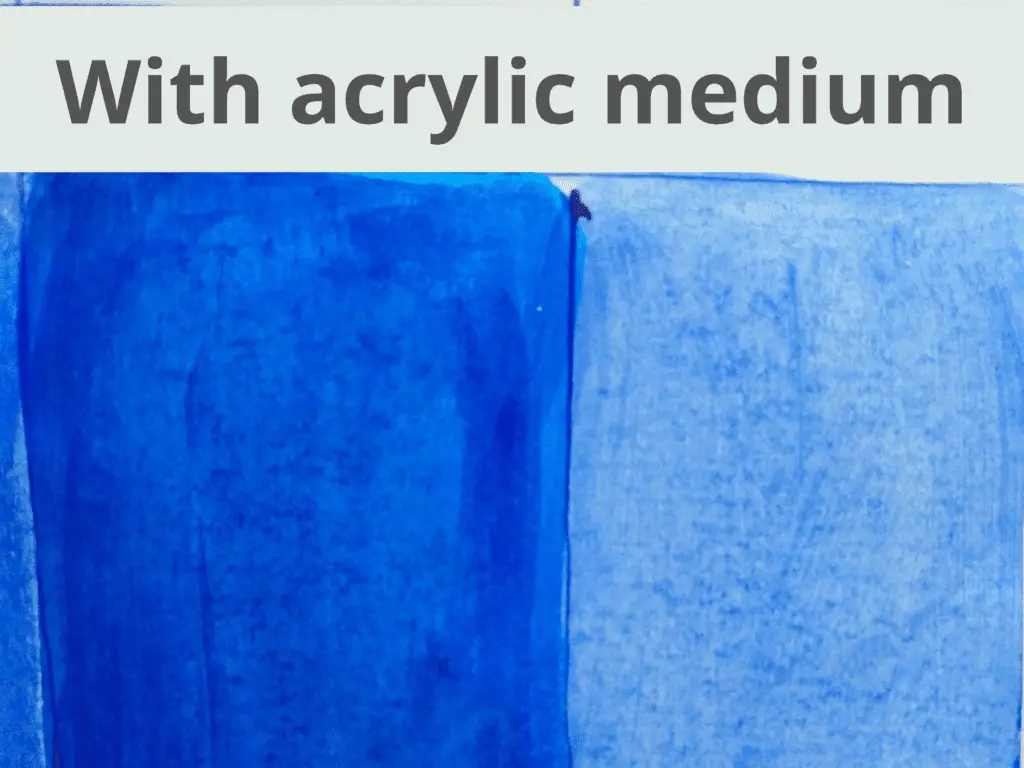
As I said before, acrylic paint can be thinned with acrylic mediums. You can see in the image, that after mixing with acrylic medium acrylic paint looks more vibrant, and did not lose its properties. I have also mixed tempera paint with acrylic medium to see what happens. As you can see, no significant difference happens with tempera paint. It has the same washy paint look.
The bottom line
Tempera paint is nontoxic inexpensive paint made for kids’ art projects. Acrylic paint is used by artists to paint on canvases but is also used in many craft projects. As they are not made for kids, the paint can be toxic if ingested. Tempera paint is more translucent and takes more time to dry. Acrylic paint is mostly opaque and dries very quickly.
Tempera paint is not good for permanent artwork that you need to keep for a long time. But acrylic paint has archival qualities. Some artists use tempera paint for acrylic pour projects. But these pours do not have the same properties as acrylic pours. However, tempera paint will be a great way for your kids to try acrylic pour art.

